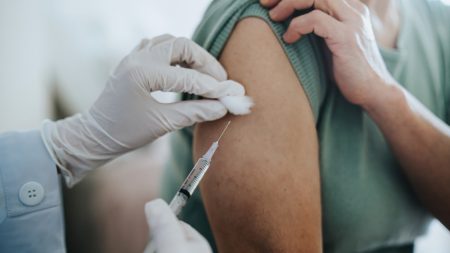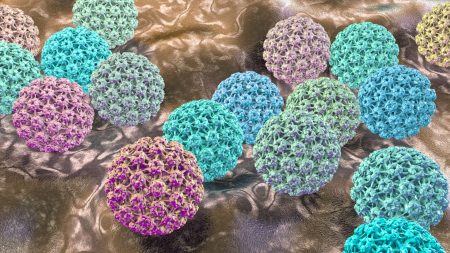The Link Between Head Injuries, Viral Reactivation, and Alzheimer’s Disease
A groundbreaking study from Oxford University has shed new light on the potential connection between head injuries, viral reactivation, and the development of Alzheimer’s disease. While previous research has established a link between repeated head injuries and dementia, this study delves deeper into the underlying mechanisms, suggesting that even mild brain trauma can trigger a cascade of events leading to neurodegenerative changes. The researchers propose that physical trauma to the brain can reactivate dormant viruses, such as the herpes simplex virus type 1 (HSV-1), commonly known as the cold sore virus. This reactivation initiates an inflammatory response within the brain, culminating in the accumulation of beta-amyloid plaques and the formation of harmful tau proteins, both hallmarks of Alzheimer’s disease.
The study utilized a 3D bioengineered human brain tissue model to simulate the effects of repeated mild blows, mimicking concussions experienced in sports or other head injuries. Upon exposure to these simulated traumas, dormant HSV-1 within the brain tissue became active, triggering the aforementioned inflammatory response and the subsequent development of Alzheimer’s-like changes. The researchers were able to further validate their findings by blocking an inflammatory molecule called Interleukin-1 beta (IL-1β), which significantly reduced the harmful effects of viral reactivation in the lab models. This discovery holds immense promise for potential new treatments aimed at preventing or mitigating the neurodegenerative consequences of head injuries.
The Role of Viruses in Alzheimer’s Disease Development
The study’s findings provide a compelling mechanism linking head injuries to Alzheimer’s disease through viral reactivation. The lead researcher, Professor Ruth Itzhaki, has dedicated over three decades to investigating the role of HSV-1 in Alzheimer’s development. Her previous work has demonstrated the involvement of common viruses, including HSV-1 and varicella zoster virus (VZV), in the pathogenesis of Alzheimer’s. HSV-1, in particular, has been shown to undergo reactivation within brain cells, causing changes that mirror those observed in Alzheimer’s patients, such as amyloid plaque-like formations, gliosis, neuroinflammation, and decreased functionality. This new research solidifies the connection between viral reactivation and Alzheimer’s by demonstrating how head injuries can serve as a trigger for this process.
The implications of this study extend beyond the realm of sports-related head injuries. While the research focused on the context of sports, the findings suggest that any form of head trauma, even seemingly minor ones, could potentially reactivate dormant viruses and initiate the cascade of events leading to neurodegenerative changes. This underscores the importance of recognizing and addressing even mild head injuries to minimize the long-term risk of developing Alzheimer’s disease. Furthermore, the study highlights the complex interplay between viral infections, inflammation, and neurodegeneration, providing a more nuanced understanding of the factors contributing to Alzheimer’s development.
Implications for Prevention and Treatment
The identification of a specific inflammatory molecule, IL-1β, as a key player in the neurodegenerative process opens exciting avenues for the development of targeted therapies. By blocking the action of IL-1β, researchers were able to prevent many of the harmful effects associated with viral reactivation in the lab models. This finding suggests that drugs targeting IL-1β or other inflammatory pathways could potentially protect against or delay the onset of Alzheimer’s disease in individuals at risk due to head injuries. Furthermore, the study underscores the importance of early intervention and preventative measures for those who have experienced head trauma.
While the study’s findings offer promising avenues for future research and treatment development, it is crucial to acknowledge that exercise and participation in sports, including contact sports, remain important for overall health and well-being. Regular physical activity has been shown to reduce the risk of dementia, including Alzheimer’s disease. However, it is essential to ensure that sports are played as safely as possible to minimize the risk of head injuries. The sporting industry, along with athletes and coaches, must prioritize player safety and implement strategies to reduce concussions and other head traumas.
Alzheimer’s Disease: Symptoms and Diagnosis
Alzheimer’s disease, the most common form of dementia, is characterized by a progressive decline in cognitive function, affecting memory, thinking, and behavior. The symptoms typically develop gradually over several years and can sometimes be mistaken for normal aging. Early symptoms often include memory lapses, difficulty finding words, and challenges with problem-solving and decision-making. As the disease progresses, individuals may experience more severe memory loss, confusion, disorientation, and personality changes.
If you are concerned about your memory or suspect you may be experiencing symptoms of dementia, it is crucial to consult a healthcare professional for a thorough evaluation. Early diagnosis is essential for effective management of Alzheimer’s disease and can help individuals and their families access appropriate support and resources. A medical evaluation typically involves a review of medical history, cognitive testing, and sometimes brain imaging to rule out other potential causes of cognitive impairment.
Conclusion: A Paradigm Shift in Alzheimer’s Research
This groundbreaking research provides a paradigm shift in our understanding of Alzheimer’s disease by illuminating the intricate interplay between head injuries, viral reactivation, and neuroinflammation. The study’s findings offer hope for the development of novel therapeutic strategies targeting inflammatory pathways to prevent or mitigate the neurodegenerative consequences of head trauma. While further research is needed to translate these findings into clinical applications, this study represents a significant step forward in the ongoing quest to combat Alzheimer’s disease and other forms of dementia. By unraveling the complex mechanisms underlying neurodegeneration, we move closer to developing effective treatments and preventative measures for this devastating disease.











